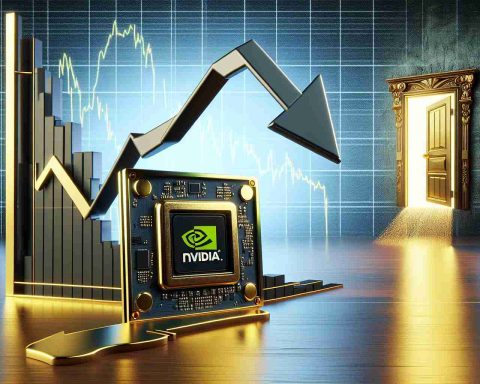- DeepSeek’s R1 reasoning model poses significant competition to OpenAI, triggering stock volatility in semiconductor giants.
- Nvidia and Broadcom’s stocks fell sharply, revealing the impact of emerging AI technologies on traditional infrastructure.
- Conversely, tech giants like Apple and Meta Platforms saw stock increases, highlighting resilience amid industry shifts.
- Meta Platforms is strategically leveraging AI to bolster user engagement and drive revenue, despite setbacks in its Reality Labs venture.
- Analysts view Meta as a solid investment opportunity due to its strong operating margins and favorable earnings outlook.
- The evolving AI landscape calls for a reassessment of investment strategies, encouraging consideration of companies like Meta.
On January 27, stock market chaos erupted following the unveiling of DeepSeek’s new R1 reasoning model, a powerful competitor to OpenAI’s technology. This news sent semiconductor giants like Nvidia and Broadcom reeling, with their stocks plummeting between 13% to 17%. However, amid the turmoil, tech titans like Apple surged, with shares skyrocketing by 3%, while Meta Platforms also gained traction.
DeepSeek’s breakthrough signifies a potential turn in AI investment strategies. With the capability to develop cutting-edge models at a fraction of the cost, the demand for traditional AI infrastructure could fall, affecting companies like Nvidia. However, a quick recovery seen in Nvidia’s stock highlights how reduced costs could spur greater AI adoption among smaller firms.
In this shifting landscape, Meta Platforms emerges as a standout contender in the AI arena. The tech powerhouse is leveraging AI to enhance user engagement, driving revenue even as it invests heavily in research and development. Despite facing losses from its Reality Labs venture, Meta has impressively maintained operating margins close to 40%.
Meta is not only resilient but presents a savvy investment opportunity. Analysts maintain that its reasonable valuation against soaring earnings paints a promising picture for future growth. While Nvidia’s journey may be fraught with volatility, Meta’s strategic focus on AI makes it a compelling choice for risk-conscious investors looking to capitalize on the evolving tech horizon.
Takeaway: As the AI landscape transforms, don’t overlook the potential in Meta Platforms—the stock could redefine your investment strategy as demand for innovative technology continues to rise.
A Major Shift: How DeepSeek’s R1 Model Could Change the Investment Landscape
The Impact of DeepSeek’s R1 Model on the Tech Market
On January 27, the launch of DeepSeek’s new R1 reasoning model sent shockwaves through the stock market, disrupting established players in the semiconductor industry. With its advanced capabilities emerging as a serious competitor to OpenAI’s technologies, stocks of major semiconductor firms like Nvidia and Broadcom dropped significantly, falling between 13% and 17%. In contrast, companies like Apple and Meta Platforms have seen positive movement in their stock prices, reflecting a dynamic shift in investor sentiment and strategic focus in the tech sector.
Key Innovations and Market Insights
The introduction of DeepSeek’s R1 model is not just a technological leap; it represents a fundamental shift in AI investment strategies. Here are some crucial elements to consider:
– Cost Efficiency: DeepSeek’s R1 model can develop high-performance models at significantly lower costs than traditional infrastructure, potentially decreasing the demand for services provided by established companies like Nvidia.
– Increased AI Adoption: Lower operational costs could lead to a surge in AI adoption among smaller firms that previously found high-performance AI models financially prohibitive.
– Meta’s Strategic Positioning: Meta Platforms is well-positioned to benefit from this trend. By integrating AI into its core business functions to enhance user engagement, Meta is continuing to grow revenue while balancing heavy investments in research and development, making it an attractive investment option.
Pros and Cons of Investing in AI Technology
Pros:
– High Growth Potential: Companies investing in AI are witnessing substantial revenue growth. Meta, with its robust operating margins around 40%, exemplifies this.
– Diversification Opportunities: With the emergence of new technologies like DeepSeek’s R1, investors can diversify their portfolios into companies that leverage innovative AI solutions.
Cons:
– Market Volatility: The tech market can be unpredictable, as evidenced by the fluctuations in Nvidia’s stock following the R1 announcement.
– Uncertain Regulatory Environment: The fast pace of AI development attracts scrutiny, and changing regulations could impact business operations.
Future Trends and Predictions
The AI landscape is set for rapid evolution, prompting predictions that companies rapidly adapting to these changes will thrive. Industry analysts expect:
– Increased Competition: As more companies develop similar models to DeepSeek’s R1, competition will intensify, potentially compressing profit margins.
– Focus on Sustainability: Investors will increasingly prioritize companies that demonstrate a commitment to sustainable AI solutions, affecting long-term profitability.
Frequently Asked Questions
1. What capabilities does DeepSeek’s R1 model have?
The R1 model is designed to provide advanced reasoning and decision-making capabilities, enabling businesses to run sophisticated AI applications more efficiently and at lower costs.
2. How is Meta adapting to the current AI trends?
Meta is investing heavily in AI technology to boost user engagement and advertising revenue while maintaining operational efficiency, setting itself apart as a resilient and promising investment.
3. What are the implications for Nvidia and broad semiconductor companies?
Nvidia and similar companies may face challenges due to reduced demand for their traditional models; however, they could also benefit from AI adoption among smaller firms investing in AI technologies.
For further insights and updates on the tech industry, visit TechCrunch.



















